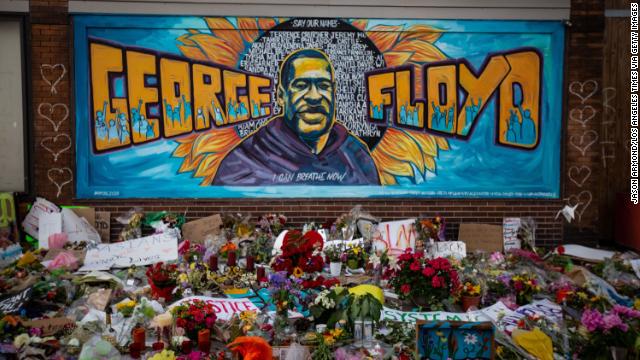Bystanders who witnessed Floyd’s death explain their horror
They included a 9-year-old girl, three high school students, a mixed martial arts fighter and a Minneapolis firefighter. Several said they had gone to the Cup Foods corner store in Minneapolis for a snack or other small item on May 25 last year — only to witness Floyd’s last breaths.
“I was sad and kind of mad,” the 9-year-old testified Tuesday. “Because it felt like he was stopping his breathing, and it was kind of like hurting him.”
The MMA fighter, Donald Wynn Williams II, testified that he was so disturbed by what he saw that he called 911 to report it. “I called the police on the police,” he said. “I believed I witnessed a murder.”
Minneapolis firefighter Genevieve Hansen, who was out for a walk on her day off, testified she wanted to render aid to Floyd and repeatedly asked police to check for a pulse, but the officers refused.
“I tried calm reasoning, I tried to be assertive, I pled and was desperate,” she testified. “I was desperate to give help.”
“I look at that and I look at how that could have been one of them,” she said through tears. “It’s been nights I’ve stayed up apologizing to George Floyd for not doing more and not physically interacting and not saving his life. But it’s not what I should have done, it’s what he should have done.”
The third high school student said she saw Chauvin dig his knee into Floyd’s neck. She said at one point Chauvin got out his mace and started shaking it as bystanders called on officers to get off Floyd.
“I was scared of Chauvin,” she said.
The testimony in Chauvin’s trial comes 10 months after Floyd’s death launched a summer of protest, unrest and a societal reckoning with America’s past and present of anti-Black racism and aggressive policing.
Chauvin, 45, has pleaded not guilty to charges of second-degree unintentional murder, third-degree murder and second-degree manslaughter.
Blackwell offered jurors a clear and simple case against Chauvin largely centered on video evidence.
“You can believe your eyes that it’s a homicide,” he said. “You can believe your eyes.”
In response, Nelson argued that the case was more complicated than just that video. He said Chauvin was following his police use of force training and argued Floyd’s cause of death was a combination of drug use and preexisting health issues.
“The use of force is not attractive, but it is a necessary component of policing,” he said.
Witness says Chauvin used ‘blood choke’
He testified that he had gone fishing with his son earlier that day.
Relying on his own MMA experience, Williams said that Chauvin performed a “blood choke” on Floyd and adjusted his positioning several times to maintain pressure on Floyd’s neck. He said he wanted to get Chauvin off Floyd but didn’t physically intervene because former Minneapolis Police officer Tou Thao was directing him to stay away.
“I just was really trying to keep my professionalism and make sure I speak out for Floyd’s life because I felt like he was in very much danger,” he said.
In a contentious cross-examination, Williams acknowledged that he had repeatedly called Chauvin and Thao names and yelled at them even after Floyd had been taken away in an ambulance. Yet he rejected defense attorney Eric Nelson’s description that he had grown “angry” on the scene.
“I grew professional. I stayed in my body. You can’t paint me out to be angry,” he said.
He was the second witness to report police’s behavior to the police. On Monday, a Minneapolis 911 dispatcher testified that she was able to watch live video of Floyd’s arrest — and called a police sergeant afterward to voice her concerns.
What it’s like in the courtroom
Only one member of Floyd’s family is allowed to attend the trial each day, and on Monday Floyd’s brother Philonise Floyd took that spot in court.
Philonise Floyd told CNN on Tuesday that being in the courtroom was an “emotional roller-coaster.”
“Those are the things that I think about when I think about my brother. He was a protector, he was someone who we can go to when we were in trouble and in need of anything.”
His place in the courtroom was just feet from Chauvin, who has been taking notes on a large notepad during jury selection and the trial.
“I’ve seen him. I watched him. I watched the reaction when the witnesses were responding to questions they were asked,” Philonise Floyd said.
“He’s in there, he’s fighting for his life, just like I’m fighting for my brother’s life. We’ve seen the video. We have facts. They’re in there trying to assassinate his character. When you don’t have facts, that’s what you have to do.”
The second-degree murder charge says Chauvin intentionally assaulted Floyd with his knee, which unintentionally caused Floyd’s death. The third-degree murder charge says Chauvin acted with a “depraved mind, without regard for human life,” and the second-degree manslaughter charge says Chauvin’s “culpable negligence” caused Floyd’s death.
Chauvin could be convicted of all, some, or none of the charges. Minnesota’s sentencing guidelines recommend about 12.5 years in prison for each murder charge and about four years for the manslaughter charge.
Witness testimony in the trial is expected to last about four weeks, followed by jury deliberations.
![]()









